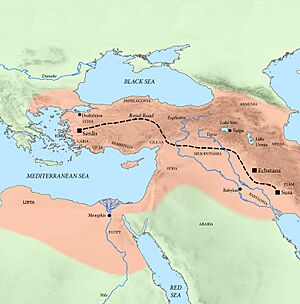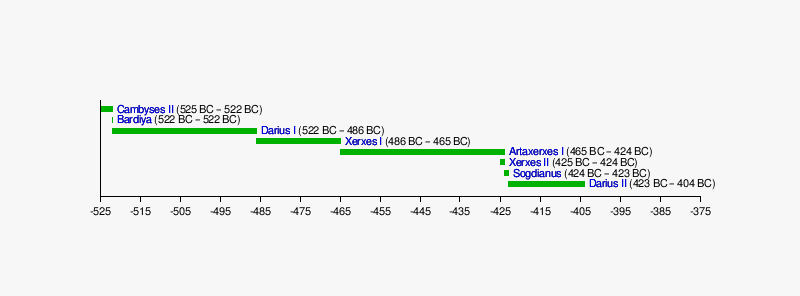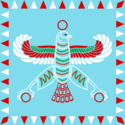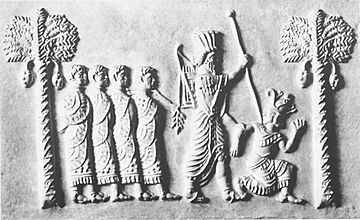
This ancient seal shows a Persian king. He is holding a spear towards an Egyptian pharaoh. Four captives are tied on a rope, showing his power.
The Twenty-seventh Dynasty of Egypt (also called Dynasty XXVII or 27th Dynasty) was a time when Egypt was part of the Achaemenid Empire. This empire was a huge Persian kingdom. This period lasted from 525 BC to 404 BC.
It began when Cambyses II, the King of Persia, conquered Egypt. He won the Battle of Pelusium (525 BC) and then became the Pharaoh of Egypt. This rule ended when an Egyptian named Amyrtaeus led a rebellion and became pharaoh himself. Later, Persia ruled Egypt again for a short time under the Thirty-first Dynasty of Egypt.
A New Chapter: Persian Rule in Egypt
The last pharaoh of the Twenty-sixth Dynasty of Egypt was Psamtik III. He was defeated by Cambyses II in May 525 BC. This battle happened near the Nile delta. Soon after, Cambyses became the pharaoh of Egypt. This marked the start of the 27th Dynasty.
Egypt then became a "satrapy" of the Achaemenid Empire. A satrapy was like a province, ruled by a governor called a "satrap." Egypt joined with Cyprus and Phoenicia to form the sixth satrapy. Aryandes was the first satrap in Egypt.
Cambyses II: Changes and Challenges
As pharaoh, Cambyses II made big changes. He reduced the money and resources given to many Egyptian temples. A special document, written in demotic script (an ancient Egyptian writing style), ordered these cuts. Only a few important temples, like those in Memphis and Heliopolis, kept their resources.
Cambyses left Egypt in 522 BC and died on his way back to Persia. His younger brother, Bardiya, was supposed to take over. However, many historians believe Bardiya was actually an impostor named Gaumata. They think the real Bardiya had been killed by Cambyses earlier.
Darius I: Rebellions and Reforms
Darius I suspected the impostor. He led a takeover in September 522 BC. He became the new King of Persia and Pharaoh of Egypt. Darius spent much of his time putting down revolts across his vast empire.
Around 522 BC or 521 BC, an Egyptian prince named Petubastis III led a rebellion. He declared himself pharaoh. The Greek historian Polyaenus said this revolt was because of high taxes. Polyaenus also wrote that Darius himself came to Egypt. He arrived during a time of sadness for the death of a sacred bull, the Herald of Ptah. Darius offered a large reward to anyone who could find the next sacred bull. This impressed the Egyptians, and they joined his side, ending the rebellion.
Darius I showed more interest in Egypt than Cambyses. He helped write down Egypt's laws. He also finished a canal system at Suez. This canal connected the Bitter Lakes to the Red Sea. It made travel much easier than crossing the desert. This allowed Darius to bring skilled Egyptian workers to build his palaces in Persia. This led to a "brain drain" in Egypt, meaning many talented people left. This caused a drop in the quality of Egyptian art and buildings during this time.
However, Darius was more supportive of Egyptian temples than Cambyses. He gained a reputation for respecting different religions. In 497 BC, Darius visited Egypt. He had the satrap Aryandes executed for treason. Aryandes had tried to make his own coins, which was seen as an attempt to separate Egypt from the Persian Empire. Darius died in 486 BC, and his son Xerxes I became the next ruler.
Xerxes I: Tighter Control
When Xerxes I became king, Egypt rebelled again. This time, it might have been led by Psamtik IV. Xerxes quickly stopped the rebellion. He put his brother Achaemenes in charge as satrap.
Xerxes ended the special status Egypt had under Darius. He demanded more supplies from Egypt, likely to pay for his invasion of Greece. Xerxes also promoted the Zoroastrian god Ahura Mazda over Egyptian gods. He stopped funding Egyptian monuments. Xerxes was killed in 465 BC. This led to a power struggle, and Artaxerxes I became the next King and Pharaoh.
Artaxerxes I: Major Revolts
In 460 BC, another big Egyptian rebellion started. It was led by a Libyan chief named Inaros II. The Athenians from Greece helped him. Inaros defeated a Persian army and killed the satrap Achaemenes. He took control of Memphis and much of Egypt.
Inaros and his Athenian allies were finally defeated by a Persian general named Megabyzus in 454 BC. Megabyzus promised Inaros safety if he surrendered. Inaros agreed, but Artaxerxes later had him executed. Artaxerxes died in 424 BC.
The End of the 27th Dynasty
Artaxerxes' successor, Xerxes II, ruled for only 45 days before being killed by his brother Sogdianus. Sogdianus was then killed by his brother Ochus, who became Darius II.
Darius II ruled from 423 BC to 404 BC. Towards the end of his reign, a rebellion led by Amyrtaeus began. In 405 BC, Amyrtaeus, with the help of soldiers from Crete, drove the Persians out of Memphis. He declared himself pharaoh the next year, ending the 27th Dynasty.
Darius II's successor, Artaxerxes II, tried to take Egypt back. But problems with his brother Cyrus the Younger stopped him. Even though Artaxerxes II was still seen as the rightful pharaoh in some parts of Egypt until 401 BC, his slow response allowed Egypt to become truly independent.
After this, three Egyptian dynasties ruled independently: the 28th, 29th, and 30th Dynasty. Later, Artaxerxes III briefly reconquered Egypt in 343 BC. This short period is known as the 31st Dynasty.
Historians used to think Persian rule in Egypt was weak or harsh. But new studies suggest that the Persian influence was important. Egyptians had many different experiences during this time.
Leaders of the 27th Dynasty
The pharaohs of the 27th Dynasty ruled for about 121 years. This was from 525 BC to 404 BC. The rulers with a violet background were native Egyptian pharaohs who rebelled against the Persian rule.
| Name of pharaoh |
Image |
Reign |
Throne name |
Important Notes |
| Cambyses II |
 |
525–522 BC |
Mesutire |
Defeated Psamtik III at the Battle of Pelusium. |
| Bardiya/ Gaumata |
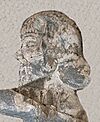 |
522 BC |
|
Possibly an impostor who pretended to be Bardiya. |
| Petubastis III |
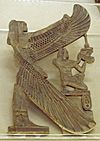 |
522/521–520 BC |
Seheruibre |
Led a rebellion against the Persian pharaohs. |
| Darius I the Great |
 |
522–486 BC |
Seteture |
|
| Psamtik IV |
|
480s BC |
|
Thought to be a rebel against the Persian pharaohs. |
| Xerxes I the Great |
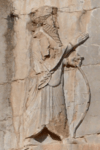 |
486–465 BC |
|
|
| Artabanus |
|
465–464 BC |
|
Killed Xerxes I, but was later killed by Artaxerxes I. |
| Artaxerxes I |
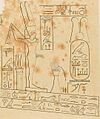 |
465–424 BC |
|
|
| Xerxes II |
|
425–424 BC |
|
Claimed the throne for a very short time. |
| Sogdianus |
|
424–423 BC |
|
Also claimed the throne briefly. |
| Darius II |
 |
423–404 BC |
|
The last pharaoh of the 27th Dynasty. |
Timeline of Persian Pharaohs
Important Satraps of Egypt
Satraps were the governors of the Persian provinces. Here are some of the key satraps who ruled Egypt during the 27th Dynasty:
| Name of Satrap |
Time in Rule |
Ruling Persian Monarch |
Notes |
| Aryandes |
525–522 BC; 518–c.496 BC |
Cambyses II, Darius I |
He was removed from power after a revolt, then put back in charge. Later, Darius I removed him again. |
| Pherendates |
c.496–c.486 BC |
Darius I |
He might have been killed during a revolt. |
| Achaemenes |
c.486–459 BC |
Xerxes I, Artaxerxes I |
He was the brother of Xerxes I. He was later killed by the rebel leader Inaros II. |
| Arsames |
c.454–c.406 BC |
Artaxerxes I, Xerxes II, Artaxerxes II |
He was the longest-serving satrap of Egypt. |
Historical Records
Historians learn about this period from several ancient writers:
See Also
- Thirty-first Dynasty of Egypt (343 BC–332 BC) — This was the second time Persia ruled Egypt.
Images for kids
-
-
A modern print from an ancient Persian seal. It shows a king holding two lion-like creatures. Egyptian hieroglyphs say "Thoth is a protection over me."
-
An Egyptian soldier from the Persian army, around 470 BCE. This image is from a carving on Xerxes I's tomb.
-
An Egyptian vase made of alabaster. It has writing in four languages, including Egyptian hieroglyphs and cuneiform. The hieroglyphs say: "King of Upper and Lower Egypt, Lord of the Two Lands, Darius, living forever, year 36."
|
Territories/
dates
|
Egypt |
Canaan |
Ebla |
Mari |
Akshak/
Akkad |
Kish |
Uruk |
Adab |
Umma
|
Lagash |
Ur |
Elam |
|
Preceded by: Chronology of the Neolithic period |
| 4000–3200 BCE |
Naqada culture (4000–3100 BCE) |
Proto-Cannaanites |
Ubaid period (6500–3800 BCE) |
Susa I |
|
Naqada I
Naqada II
 |
Egypt-Mesopotamia relations |
Uruk period
(4000-3100 BCE)

(Anonymous "King-priests")
|
Susa II

(Uruk influence or control) |
| 3200–3100 BCE |
Proto-Dynastic period
(Naqada III)
Early or legendary kings: |
Upper Egypt
Finger Snail Fish Pen-Abu Animal Stork Canide Bull Scorpion I Shendjw Iry-Hor Ka Scorpion II Narmer / Menes |
Lower Egypt
Hedju Hor Ny-Hor Hsekiu Khayu Tiu Thesh Neheb Wazner Nat-Hor Mekh Double Falcon Wash
|
| 3100–2900 BCE |
Early Dynastic Period
First Dynasty of Egypt
Narmer Menes Neithhotep♀ (regent) Hor-Aha Djer Djet Merneith♀ (regent) DenAnedjib Semerkhet Qa'a Sneferka Horus Bird |
Canaanites |
Jemdet Nasr period |
Proto-Elamite
period
(Susa III)
(3100-2700 BCE) |
|
| 2900 BCE |
Second Dynasty of Egypt
Hotepsekhemwy Nebra/Raneb Nynetjer Ba Nubnefer Horus Sa Weneg-Nebty Wadjenes Senedj Seth-Peribsen Sekhemib-Perenmaat Neferkara I Neferkasokar Hudjefa I Khasekhemwy
 |
Early Dynastic Period I (2900–2700 BCE) |
First Eblaite
Kingdom
|
First kingdom
of Mari
|
Kish I dynasty
Jushur, Kullassina-bel
Nangishlishma,
En-tarah-ana
Babum, Puannum, Kalibum |
| 2800 BCE
|
Kalumum Zuqaqip Atab
Mashda Arwium Etana
Balih En-me-nuna
Melem-Kish Barsal-nuna |
Uruk I dynasty
Mesh-ki-ang-gasher |
| Enmerkar ("conqueror of Aratta") |
| 2700 BCE |
Early Dynastic Period II (2700–2600 BCE) |
|
|
Zamug, Tizqar, Ilku
Iltasadum |
Lugalbanda
Dumuzid, the Fisherman
|
| Enmebaragesi ("made the land of Elam submit") |
Aga of Kish  |
|
Old Elamite period
(2700–1500 BCE)
Indus-Mesopotamia relations |
| 2600 BCE |
Third Dynasty of Egypt
Djoser Sekhemkhet Sanakht Nebka Khaba Qahedjet Huni
 |
Early Dynastic Period III (2600–2340 BCE) |
Sagisu
Abur-lim
Agur-lim
Ibbi-Damu
Baba-Damu |
|
Kish II dynasty
(5 kings)
Uhub
Mesilim |
Ur-Nungal
Udulkalama
Labashum |
Lagash
En-hegal
Lugalshaengur |
Ur
A-Imdugud
Ur-Pabilsag 
Meskalamdug
(Queen Puabi)
Akalamdug |
Enun-dara-anna
Mes-he
Melamanna
Lugal-kitun |
Adab
Nin-kisalsi
Me-durba
Lugal-dalu |
|
| 2575 BCE |
Old Kingdom of Egypt
Fourth Dynasty of Egypt
Snefru Khufu

Djedefre Khafre Bikheris Menkaure Shepseskaf Thamphthis |
Ur I dynasty
Mesannepada
"King of Ur and Kish", victorious over Uruk |
| 2500 BCE |
Phoenicia (2500-539 BCE) |
Second kingdom
of Mari
Ikun-Shamash
Iku-Shamagan

Ansud
Sa'umu
Ishtup-Ishar
Ikun-Mari
Iblul-Il
Nizi |
Akshak dynasty
Unzi
Undalulu |
Kish III dynasty
Ku-Baba |
Uruk II dynasty
Enshakushanna |
Mug-si |
Umma I dynasty
Pabilgagaltuku |
Lagash I dynasty
Ur-Nanshe

Akurgal |
A'annepada
Meskiagnun
Elulu
Balulu |
Awan dynasty
Peli
Tata
Ukkutahesh
Hishur |
| 2450 BCE |
Fifth Dynasty of Egypt
Userkaf Sahure Neferirkare Kakai Neferefre Shepseskare Nyuserre Ini Menkauhor Kaiu Djedkare Isesi Unas |
Enar-Damu
Ishar-Malik |
Ush
Enakalle |
Elamite invasions
(3 kings) |
Shushuntarana
Napilhush |
| 2425 BCE |
Kun-Damu |
Eannatum 
(King of Lagash, Sumer, Akkad, conqueror of Elam) |
| 2400 BCE |
Adub-Damu
Igrish-Halam
Irkab-Damu |
Urur |
Kish IV dynasty
Puzur-Suen
Ur-Zababa |
Lugal-kinishe-dudu
Lugal-kisalsi |
E-iginimpa'e
Meskigal |
Ur-Lumma
Il
Gishakidu
(Queen Bara-irnun) |
Enannatum
Entemena
Enannatum II
Enentarzi |
Ur II dynasty
Nanni
Mesh-ki-ang-Nanna II |
Kiku-siwe-tempti |
| 2380 BCE |
Sixth Dynasty of Egypt
Teti Userkare Pepi I Merenre Nemtyemsaf I Pepi II Merenre Nemtyemsaf II Netjerkare Siptah
 |
Adab dynasty
Lugalannemundu
"King of the four quarters of the world" |
| 2370 BCE |
Isar-Damu |
Enna-Dagan
Ikun-Ishar
Ishqi-Mari |
Invasion of Mari
Anbu, Anba, Bazi, Zizi of Mari, Limer, Sharrum-iter |
Ukush |
Lugalanda
Urukagina |
Luh-ishan |
| 2350 BCE
|
Puzur-Nirah
Ishu-Il
Shu-Sin |
Uruk III dynasty
Lugalzagesi
(Governor of Umma, King of all Sumer) |
| 2340 BCE |
|
Akkadian Period (2340–2150 BCE) |
Akkadian Empire
Sargon of Akkad Rimush Manishtushu |
Akkadian Governors:
Eshpum
Ilshu-rabi
Epirmupi
Ili-ishmani |
| 2250 BCE |
Naram-Sin  |
Lugal-ushumgal
(vassal of the Akkadians) |
| 2200 BCE |
First Intermediate Period
Seventh Dynasty of Egypt
Eighth Dynasty of Egypt
Menkare Neferkare II Neferkare Neby Djedkare Shemai Neferkare Khendu Merenhor Neferkamin Nikare Neferkare Tereru Neferkahor Neferkare Pepiseneb Neferkamin Anu Qakare Ibi Neferkaure Neferkauhor Neferirkare |
Second Eblaite
Kingdom
(Vassals of UR III) |
Third kingdom
of Mari
Shakkanakku
dynasty
Ididish
Shu-Dagan
Ishma-Dagan
(Vassals of the Akkadians) |
Shar-Kali-Sharri |
Igigi, Imi, Nanum, Ilulu (3 years)
Dudu
Shu-turul |
Uruk IV dynasty
Ur-nigin
Ur-gigir |
|
Lagash II dynasty
Puzer-Mama
Ur-Ningirsu I
Pirig-me
Lu-Baba
Lu-gula
Ka-ku
|
Hishep-Ratep
Helu
Khita
Puzur-Inshushinak |
| 2150 BCE |
Ninth Dynasty of Egypt
Meryibre Khety Neferkare VII Nebkaure Khety Setut |
Ur III period (2150–2000 BCE) |
Nûr-Mêr
Ishtup-Ilum

Ishgum-Addu
Apil-kin |
Gutian dynasty
(21 kings)
La-erabum
Si'um |
Kuda (Uruk)
Puzur-ili
Ur-Utu |
|
Umma II dynasty
Lugalannatum
(vassal of the Gutians) |
Ur-Baba
Gudea
Ur-Ningirsu
Ur-gar
Nam-mahani |
Tirigan |
| 2125 BCE |
Tenth Dynasty of Egypt
Meryhathor Neferkare VIII Wahkare Khety Merykare |
Iddi-ilum
Ili-Ishar
Tura-Dagan
Puzur-Ishtar
Hitial-Erra
Hanun-Dagan
(Vassals of Ur III) |
Uruk V dynasty
Utu-hengal |
| 2100 BCE
|
Ur III dynasty
"Kings of Ur, Sumer and Akkad" 
Ur-Nammu Shulgi Amar-Sin Shu-Sin Ibbi-Sin |
| 2050 BCE
|
| 2000 BCE |
Middle Kingdom of Egypt
Eleventh Dynasty of Egypt
Mentuhotep I Intef I Intef II Intef III Mentuhotep II Mentuhotep III Mentuhotep IV |
| circa 2000 BCE |
Amorite invasions |
Elamite invasions
Kindattu (Shimashki Dynasty) |
| 2025-1763 BCE |
Twelfth Dynasty of Egypt
Amenemhat I Senusret I Amenemhat II Senusret II Senusret III Amenemhat III Amenemhat IV Sobekneferu♀ |
Third Eblaite
Kingdom
Ibbit-Lim Immeya Indilimma |
Lim Dynasty
Yaggid-Lim Yahdun-Lim Yasmah-Adad Zimri-Lim (Queen Shibtu) |
Isin-Larsa period (Amorites)
Dynasty of Isin: Ishbi-Erra Shu-Ilishu Iddin-Dagan Ishme-Dagan Lipit-Eshtar Ur-Ninurta Bur-Suen Lipit-Enlil Erra-imitti Enlil-bani Zambiya Iter-pisha Ur-du-kuga Suen-magir Damiq-ilishu
Dynasty of Larsa: Naplanum Emisum Samium Zabaia Gungunum Abisare Sumuel Nur-Adad Sin-Iddinam Sin-Eribam Sin-Iqisham Silli-Adad Warad-Sin Rim-Sin I (...) Rim-Sin II
Uruk VI dynasty: Alila-hadum Sumu-binasa Naram-Sin of Uruk Sîn-kāšid Sîn-iribam Sîn-gāmil Ilum-gamil Anam of Uruk Irdanene Rim-Anum Nabi-ilišu |
Sukkalmah dynasty
Siwe-Palar-Khuppak |
| 1800–1595 BCE |
Thirteenth Dynasty of Egypt
Fourteenth Dynasty of Egypt |
Abraham
(Biblical)
Kings of Byblos
Kings of Tyre
Kings of Sidon |
Yamhad |
Old Assyrian Empire
(2025–1378 BCE)
Puzur-Ashur I Shalim-ahum Ilu-shuma Erishum I Ikunum Sargon I Puzur-Ashur II Naram-Sin Erishum II Shamshi-Adad I Ishme-Dagan I Mut-Ashkur Rimush Asinum Ashur-dugul Ashur-apla-idi Nasir-Sin Sin-namir Ipqi-Ishtar Adad-salulu Adasi Bel-bani Libaya Sharma-Adad I Iptar-Sin Bazaya Lullaya Shu-Ninua Sharma-Adad II Erishum III Shamshi-Adad II Ishme-Dagan II Shamshi-Adad III Ashur-nirari I Puzur-Ashur III Enlil-nasir I Nur-ili Ashur-shaduni Ashur-rabi I Ashur-nadin-ahhe I Enlil-Nasir II Ashur-nirari II Ashur-bel-nisheshu Ashur-rim-nisheshu Ashur-nadin-ahhe II |
First Babylonian dynasty
("Old Babylonian Period")
(Amorites)
Sumu-abum Sumu-la-El Sin-muballitSabium Apil-Sin Sin-muballit Hammurabi Samsu-iluna Abi-eshuh Ammi-ditana Ammi-saduqa Samsu-Ditana
Early Kassite rulers |
Second Babylonian dynasty
("Sealand Dynasty")
Ilum-ma-ili Itti-ili-nibi Damqi-ilishu
Ishkibal Shushushi Gulkishar
mDIŠ+U-EN Peshgaldaramesh Ayadaragalama
Akurduana Melamkurkurra Ea-gamil |
|
Second Intermediate Period
Sixteenth
Dynasty
Abydos
Dynasty
Seventeenth
Dynasty
|
'Fifteenth Dynasty of Egypt
("Hyksos")
Semqen Aper-'Anati Sakir-Har Khyan Apepi Khamudi |
Mitanni
(1600–1260 BCE)
Kirta Shuttarna I Parshatatar |
| 1531–1155 BCE |
New Kingdom of Egypt
Eighteenth Dynasty of Egypt
Ahmose I Amenhotep I |
Third Babylonian dynasty (Kassites)
Agum-Kakrime Burnaburiash I Kashtiliash III Ulamburiash Agum III Karaindash Kadashman-harbe I Kurigalzu I Kadashman-Enlil I Burnaburiash II Kara-hardash Nazi-Bugash Kurigalzu II Nazi-Maruttash Kadashman-Turgu Kadashman-Enlil II Kudur-Enlil Shagarakti-Shuriash Kashtiliashu IV Enlil-nadin-shumi Kadashman-Harbe II Adad-shuma-iddina Adad-shuma-usur Meli-Shipak II Marduk-apla-iddina I Zababa-shuma-iddin Enlil-nadin-ahi |
Middle Elamite period
(1500–1100 BCE)
Kidinuid dynasty
Igehalkid dynasty
Untash-Napirisha
|
| Thutmose I Thutmose II Hatshepsut♀ Thutmose III |
| Amenhotep II Thutmose IV Amenhotep III Akhenaten Smenkhkare Neferneferuaten♀ Tutankhamun Ay Horemheb |
Hittite Empire
Ugarit |
Nineteenth Dynasty of Egypt
Ramesses I Seti I Ramesses II Merneptah Amenmesses Seti II Siptah Twosret♀ |
Elamite Empire
Shutrukid dynasty
Shutruk-Nakhunte |
| 1155–1025 BCE |
Twentieth Dynasty of Egypt
Setnakhte Ramesses III Ramesses IV Ramesses V Ramesses VI Ramesses VII Ramesses VIII Ramesses IX Ramesses X Ramesses XI
Third Intermediate Period
Twenty-first Dynasty of Egypt
Smendes Amenemnisu Psusennes I Amenemope Osorkon the Elder Siamun Psusennes II
|
Phoenicia
Kings of Byblos
Kings of Tyre
Kings of Sidon
Kingdom of Israel
Saul
Ish-bosheth
David
Solomon |
Syro-Hittite states |
Middle Assyrian Empire
Eriba-Adad I Ashur-uballit I Enlil-nirari Arik-den-ili Adad-nirari I Shalmaneser I Tukulti-Ninurta I Ashur-nadin-apli Ashur-nirari III Enlil-kudurri-usur Ninurta-apal-Ekur Ashur-dan I Ninurta-tukulti-Ashur Mutakkil-Nusku Ashur-resh-ishi I Tiglath-Pileser I Asharid-apal-Ekur Ashur-bel-kala Eriba-Adad II Shamshi-Adad IV Ashurnasirpal I Shalmaneser II Ashur-nirari IV Ashur-rabi II Ashur-resh-ishi II Tiglath-Pileser II Ashur-dan II |
Fourth Babylonian dynasty ("Second Dynasty of Isin")
Marduk-kabit-ahheshu Itti-Marduk-balatu Ninurta-nadin-shumi Nebuchadnezzar I Enlil-nadin-apli Marduk-nadin-ahhe Marduk-shapik-zeri Adad-apla-iddina Marduk-ahhe-eriba Marduk-zer-X Nabu-shum-libur |
Neo-Elamite period (1100–540 BCE) |
| 1025–934 BCE |
Fifth, Sixth, Seventh, Eighth Babylonian dynasties ("Period of Chaos")
Simbar-shipak Ea-mukin-zeri Kashshu-nadin-ahi Eulmash-shakin-shumi Ninurta-kudurri-usur I Shirikti-shuqamuna Mar-biti-apla-usur Nabû-mukin-apli |
| 911–745 BCE |
Twenty-second Dynasty of Egypt
Shoshenq I Osorkon I Shoshenq II Takelot I Osorkon II Shoshenq III Shoshenq IV Pami Shoshenq V Pedubast II Osorkon IV
Twenty-third Dynasty of Egypt
Harsiese A Takelot II Pedubast I Shoshenq VI Osorkon III Takelot III Rudamun Menkheperre Ini
Twenty-fourth Dynasty of Egypt
Tefnakht Bakenranef
|
Kingdom of Samaria
Kingdom of Judah |
Neo-Assyrian Empire
Adad-nirari II Tukulti-Ninurta II Ashurnasirpal II Shalmaneser III Shamshi-Adad V Shammuramat♀ (regent) Adad-nirari III Shalmaneser IV Ashur-Dan III Ashur-nirari V |
Ninth Babylonian Dynasty
Ninurta-kudurri-usur II Mar-biti-ahhe-iddina Shamash-mudammiq Nabu-shuma-ukin I Nabu-apla-iddina Marduk-zakir-shumi I Marduk-balassu-iqbi Baba-aha-iddina (five kings) Ninurta-apla-X Marduk-bel-zeri Marduk-apla-usur Eriba-Marduk Nabu-shuma-ishkun Nabonassar Nabu-nadin-zeri Nabu-shuma-ukin II Nabu-mukin-zeri
|
Humban-Tahrid dynasty
Urtak
Teumman
Ummanigash
Tammaritu I
Indabibi
Humban-haltash III |
| 745–609 BCE |
Twenty-fifth Dynasty of Egypt
("Black Pharaohs")
Piye Shebitku Shabaka Taharqa Tanutamun |
Neo-Assyrian Empire
(Sargonid dynasty)
Tiglath-Pileser† Shalmaneser† Marduk-apla-iddina II Sargon† Sennacherib† Marduk-zakir-shumi II Marduk-apla-iddina II Bel-ibni Ashur-nadin-shumi† Nergal-ushezib Mushezib-Marduk Esarhaddon† Ashurbanipal Ashur-etil-ilani Sinsharishkun Sin-shumu-lishir Ashur-uballit II
|
| Assyrian conquest of Egypt |
|
| 626–539 BCE |
Late Period
Twenty-sixth Dynasty of Egypt
Necho I Psamtik I Necho II Psamtik II Wahibre Ahmose II Psamtik III |
Neo-Babylonian Empire
Nabopolassar Nebuchadnezzar II Amel-Marduk Neriglissar Labashi-Marduk Nabonidus |
Median Empire
Deioces Phraortes Madius Cyaxares Astyages |
| 539–331 BCE |
Twenty-seventh Dynasty of Egypt
(Achaemenid conquest of Egypt) |
Kings of Byblos
Kings of Tyre
Kings of Sidon |
Achaemenid Empire
Cyrus Cambyses Darius I Xerxes Artaxerxes I Darius II Artaxerxes II Artaxerxes III Artaxerxes IV Darius III |
Twenty-eighth Dynasty of Egypt
Twenty-ninth Dynasty of Egypt
Thirtieth Dynasty of Egypt |
| Thirty-first Dynasty of Egypt |
| 331–141 BCE |
Ptolemaic dynasty
Ptolemy I Soter Ptolemy Keraunos Ptolemy II Philadelphus Arsinoe II♀ Ptolemy III Euergetes Berenice II Euergetis♀ Ptolemy IV Philopator Arsinoe III Philopator♀ Ptolemy V Epiphanes Cleopatra I Syra♀ Ptolemy VI Philometor Ptolemy VII Neos Philopator Cleopatra II Philometor Soter♀ Ptolemy VIII Physcon Cleopatra III♀ Ptolemy IX Lathyros Cleopatra IV♀ Ptolemy X Alexander Berenice III♀ Ptolemy XI Alexander Ptolemy XII Auletes Cleopatra V♀ Cleopatra VI Tryphaena♀ Berenice IV Epiphanea♀ Ptolemy XIII Ptolemy XIV Cleopatra VII Philopator♀ Ptolemy XV Caesarion Arsinoe IV♀ |
Hellenistic Period
Argead dynasty: Alexander I Philip Alexander II Antigonus
Seleucid Empire: Seleucus I Antiochus I Antiochus II Seleucus II Seleucus III Antiochus III Seleucus IV Antiochus IV Antiochus V Demetrius I Alexander III Demetrius II Antiochus VI Dionysus Diodotus Tryphon Antiochus VII Sidetes
|
| 141–30 BCE |
Kingdom of Judea
Simon Thassi John Hyrcanus Aristobulus I Alexander Jannaeus Salome Alexandra Hyrcanus II Aristobulus II Antigonus II Mattathias |
Alexander II Zabinas Seleucus V Philometor Antiochus VIII Grypus Antiochus IX Cyzicenus Seleucus VI Epiphanes Antiochus X Eusebes Antiochus XI Epiphanes Demetrius III Eucaerus Philip I Philadelphus Antiochus XII Dionysus Antiochus XIII Asiaticus Philip II Philoromaeus |
Parthian Empire
Mithridates I Phraates Hyspaosines Artabanus Mithridates II Gotarzes Mithridates III Orodes I Sinatruces Phraates III Mithridates IV Orodes II Phraates IV Tiridates II Musa Phraates V Orodes III Vonones I Artabanus II Tiridates III Artabanus II Vardanes I Gotarzes II Meherdates Vonones II Vologases I Vardanes II Pacorus II Vologases II Artabanus III Osroes I |
| 30 BCE–116 CE |
Roman Empire |
(Roman conquest of Egypt)
Province of Egypt |
Judea |
Syria |
| 116-117 CE |
Province of Mesopotamia under Trajan |
Parthamaspates of Parthia |
| 117–224 CE |
Syria Palaestina |
Province of Mesopotamia |
Sinatruces II Mithridates V Vologases IV Osroes II Vologases V Vologases VI Artabanus IV |
| 224–270 CE |
Sasanian Empire
Province of Asoristan
Ardashir I Shapur I Hormizd I Bahram I Bahram II Bahram III Narseh Hormizd II Adur Narseh Shapur II Ardashir II Shapur III Bahram IV Yazdegerd I Shapur IV Khosrow Bahram V Yazdegerd II Hormizd III Peroz I Balash Kavad I Jamasp Kavad I Khosrow I Hormizd IV Khosrow II Bahram VI Chobin Vistahm |
| 270–273 CE |
Palmyrene Empire
Vaballathus Zenobia Antiochus |
| 273–395 CE |
Roman Empire |
| Province of Egypt |
Syria Palaestina |
Syria |
Province of Mesopotamia |
| 395–618 CE |
Byzantine Empire |
| Byzantine Egypt |
Palaestina Prima, Palaestina Secunda |
Byzantine Syria |
Byzantine Mesopotamia |
| 618–628 CE |
(Sasanian conquest of Egypt)
Province of Egypt
Shahrbaraz Sahralanyozan Shahrbaraz |
Sasanian Empire
Province of Asoristan
Khosrow II Kavad II |
| 628–641 CE |
Byzantine Empire |
Ardashir III Shahrbaraz Khosrow III Boran Shapur-i Shahrvaraz Azarmidokht Farrukh Hormizd Hormizd VI Khosrow IV Boran Yazdegerd III Peroz III Narsieh |
| Byzantine Egypt |
Palaestina Prima, Palaestina Secunda |
Byzantine Syria |
Byzantine Mesopotamia |
| 639–651 CE |
Muslim conquest of Egypt |
Muslim conquest of the Levant |
Muslim conquest of Mesopotamia and Persia |
 Rulers of Ancient Central Asia Rulers of Ancient Central Asia |
|
|
|
